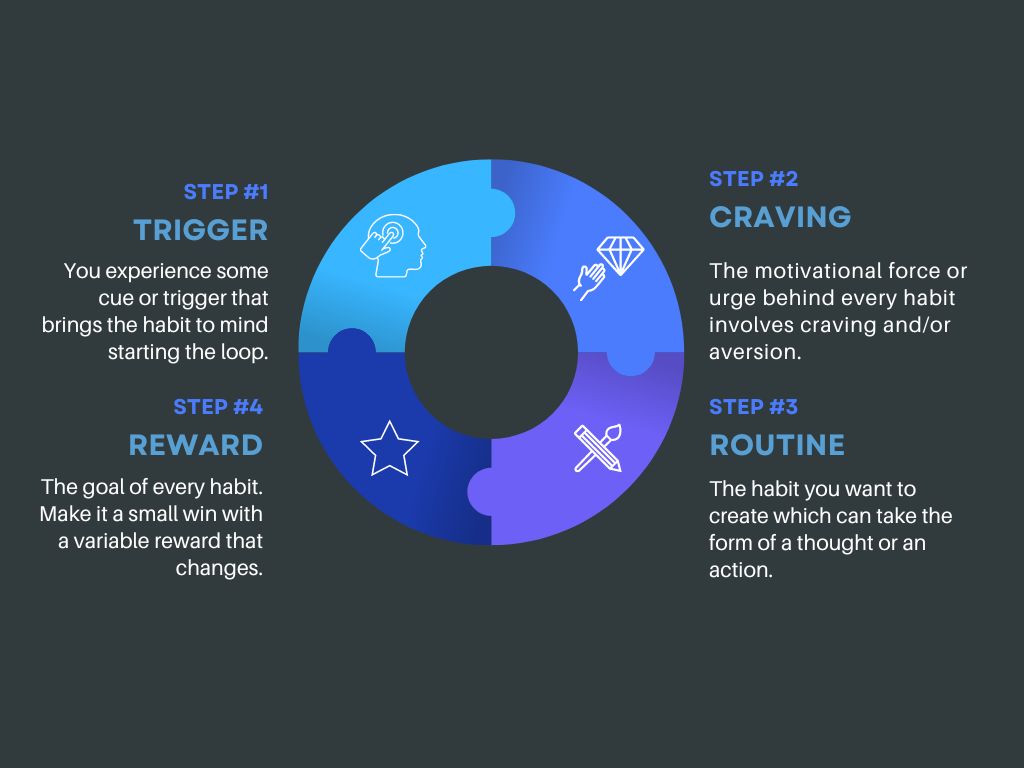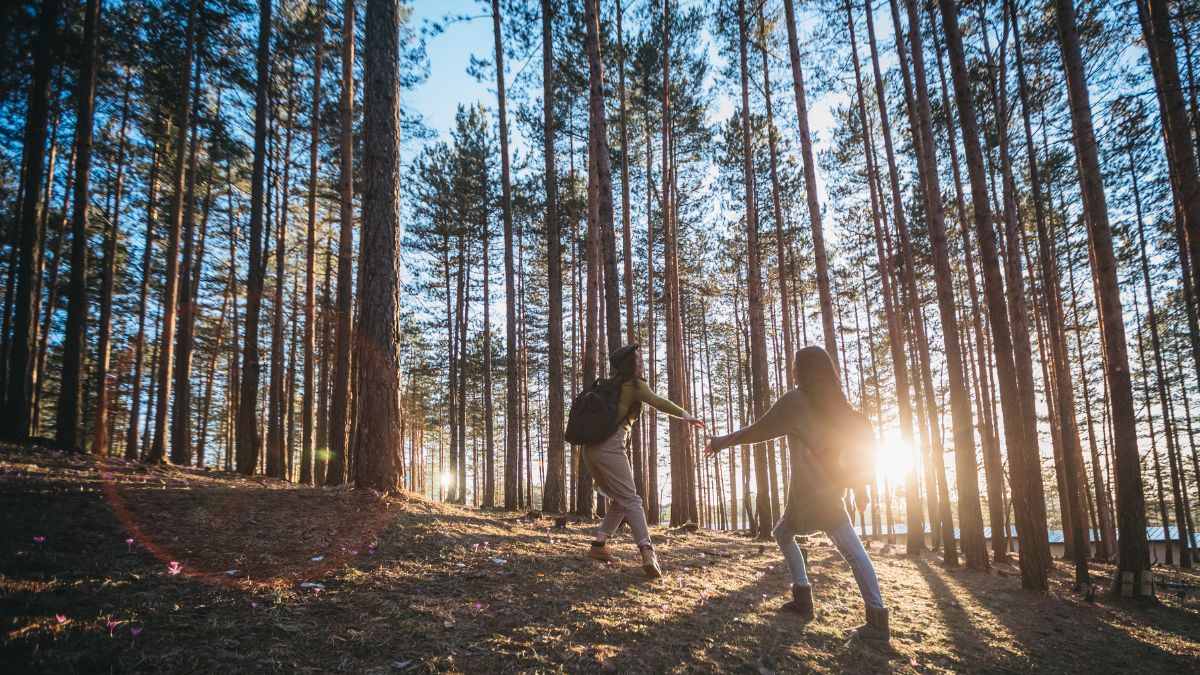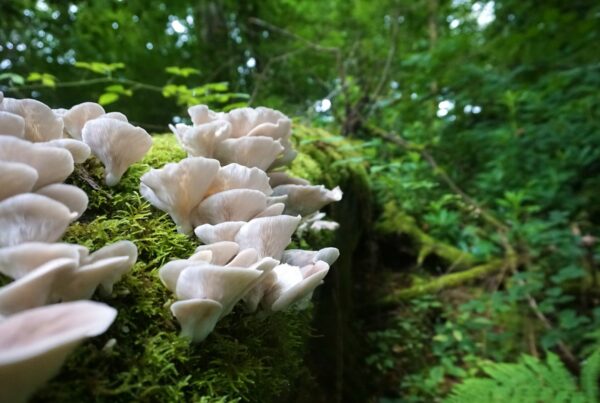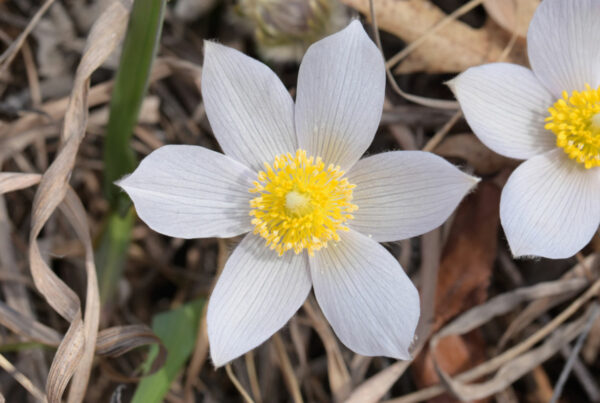Mindfulness practices typically focus on formal sitting meditation where you observe your breath and/or the thoughts, feelings and sensations that arise.
By contrast, ecological mindfulness involves mindful walking and deep embodiment in the natural world around you and using awe and wonder to naturally enter states of deep relaxation, aliveness and transcendence.
Given the sedentary nature of life today, practicing mindfulness in nature through mindful walking can be much more effective for most people who struggle with doing formal sitting meditation techniques each day.
The Art of Mindful Walking
Mindfulness in nature harnesses the natural flow and enjoyment of walking to ground yourself in the aliveness of your body, shift out of self-referential thought by relaxing your mind and connect you with spirit by feeling the sense of awe provoked by the living beauty and wonders all around you.
Mindful walking is a powerful practice to break up your time spent sitting indoors, reverse the negative effects of sitting all day for work and recharge throughout you day in short eco-mindfulness sessions outdoors.
Studies show gentle walking after meals can boost focus, energy and mood. Why not start doing a short mindful walk after every meal?
Here’s a simple 3-step process to start practicing mindfulness in nature:
1. Body: Ground yourself in your 5 senses and start to feel the aliveness in your body and in the world around you.
2. Mind: Relax your mind by tuning into your breath and allow thoughts to bubble up and pass away like clouds in the sky.
3. Spirit: Connect with spirit by shifting from identification with the self to becoming aware of the field of awareness and aliveness that you share with all living, breathing, sentience beings in the world.
7 Ways To Practice Mindfulness In Nature
“During the peak experience, the individual experiences an expansion of self, a sense of unity, and meaningfulness in life. The experience lingers in one’s consciousness and gives a sense of purpose, integration, self-determination and empathy.
The emotional reaction in the peak experience has a special flavor of wonder, of awe, of reverence, of humility and surrender before the experience as before something great.”
― Abraham Maslow
Consistent practice of mindfulness in nature is one of the best ways to have more peak experiences in your life.
Peak experiences are felt experiences of unity, connectedness and self-transcendence where we transcend our ordinary way of being lost in thought where we constantly analyze, plan, ruminate, project, judge and compare.
They can be thought of as glimpse of our true nature beyond thought and an active form of sensory immersion meditation where we become immersed in the felt experience of our immediate sensory experience.
The mind becomes quiet, our senses come alive and we may get a temporary glimpse of unity and connectedness with something greater than ourselves.
1. Flow
“It is when we act freely, for the sake of the action itself rather than for ulterior motives, that we learn to become more than what we were. When we choose a goal and invest ourselves in it to the limits of concentration, whatever we do will be enjoyable. And once we have tasted this joy, we will redouble our efforts to taste it again. This is the way the self grows.
Control of consciousness determines quality of life… the self expands through acts of self-forgetfulness.”
― Mihaly Csikszentmihalyi
A flow experience or flow state happens when we are fully immersed in an activity that is meaningful and challenging.
Flow is an optimal state of consciousness, a state of mind that occurs when you are totally immersed in an activity. It is those “in the zone” moments you feel when you bring your full attention to a personally fulfilling activity.
In a flow state you feel a sense of selflessness, timelessness, effortlessness and richness. To get in flow in any activity, we must let go of identification with our thoughts, pre-conceptions and open ourselves up to the “felt presence” of our immediate experience that comes from deep embodiment.
Flow Activity: The Treasure Hunt
The easiest way to experience flow outside is to gamify your experience by making it a treasure hunt where you can amp up the novelty, complexity and unpredictability of the activity.
Download the app Seek by iNaturalist and see how many local species of plants, mushrooms, trees, animals and birds you can identify in the forest in an hour. Make it a fun and playful experience that you can do alone or with friends or family members to enhance the shared sense of adventure (what’s called “group flow”).
2. Mindfulness
“Mindfulness is awareness that arises through paying attention, on purpose, in the present moment, non-judgmentally, in the service of self-understanding and wisdom.”
― Dr. Jon Kabat-Zinn
Mindfulness in nature involves shifting from a self-focus to an ecological focus…. is a type of meditation in which you focus on being aware of thoughts, feelings and and sensations without judgement, labelling or evaluation.
The two most researched forms of deliberate mindfulness are focused attention mindfulness, which involves a single-point of focus like witnessing the breath and open monitoring mindfulness, which involves observing thoughts, feelings and sensations without judgement or identification.
There are also lesser known effortless mindfulness practices like nondual awareness, which involve tuning into the wider field of embodied awareness and resting in the knowing that is at the center of all experience.
Mindfulness Activity: Grounding In Your 5 Senses
Next time you go for a walk outside start by grounding yourself in your 5 senses with this exercise:
1. Sight: What are 5 things you can see?
2. Touch: What are 4 things you can touch?
3. Hearing: What are 3 things you can hear?
4. Smell: What are 2 things you can smell?
5. Taste: What is 1 thing you can taste?
Once you have grounded yourself, walk mindfully observing the beauty of all the colours, patterns, textures, light, shadows and flowing movement caused by the wind that captures your attention.
3. Gratitude
“Gratitude bestows reverence, allowing us to encounter
everyday epiphanies, those transcendent moments of awe
that change forever how we experience life and the world.”
― John Milton
Gratitude is a positive emotion that involves being thankful and appreciative for things given to you. It can be both a spontaneous experience and something that can be easily cultivated through deliberate practice.
The practice of gratitude can be as simple as remembering 3-5 moments you are grateful for each day when you go to bed, keeping a gratitude journal to reflect on your life, paying attention to the little wonders of everyday life that bring you joy, or making time to do something kind for another person to demonstrate your gratitude through thoughtful actions.
Gratitude Activity: Kissing The Earth
Experience the world around you with a sense of gratitude and reverence. Go for a mindful walk and use the mantra from the mindfulness teacher Zen monk Thich Nhat Hanh, “walk as if your feet are kissing the earth.”
It helps to remove your shoes and walk somewhere like a soft path, sandy beach or grassy field where you can fully sense and appreciate the earth under your feet through all the sensory ending on the bottom of each foot.
As you’re walking, feel a sense of reverence and gratitude for all the
elements that give you life: earth, air, water, light and ether (space itself).
4. Love
“Real change will only happen when we fall in love with our planet. Only love can show us how to live in harmony with nature and with each other and save us from the devastating effects of environmental destruction and climate change.”
― Thich Nhat Hanh
Loving kindness is a powerful practice, which helps cultivate resiliency, self-compassion and empathy for people and the more-than-human world.
Kindness, compassion, sympathy and empathy are some of our most beautiful qualities. The cultivation of all of these felt experiences activates our vagus nerve, which makes us much more resilient against stress, anxiety and burnout.
Loving kindness is important in combination with mindfulness practices because mindfulness without the heartfelt goal of the liberation of all sentient beings goes against the entire point of why it was created.
Love Activity: The Helper’s High
The world desperately needs more simple acts of love and compassion. This could be befriending an elderly person and regularly going on a walk outside with them, joining a local tree planting or invasive species removal event, or doing something else regularly that gives back to your local community.
I recommend hiking with small tweezers and reusable jar or bag in your backpack that you can use to pick up a few pieces of garbage each time you’re on a hike. Just the small act of picking up garbage is a simple act of love that not only feels good for you but it also improves the environment for small animals and increases the enjoyment for other people.
5. Awe
There are two ways to live: you can live as if nothing is a miracle; you can live as if everything is a miracle. The most beautiful thing we can experience is the mysterious. It is the source of all true art and all science. He to whom this emotion is a stranger, who can no longer pause to wonder and stand rapt is awe, is as good as dead: his eyes are closed.
― Albert Einstein
Awe is the feeling of being in the presence of something vast and mysterious that transcends your understanding of the world.
Regular experiences of awe, wonder and reverence have been found to significantly boost immunity, improve mood and quiet the body’s inflammatory stress response.
Awe is considered the ultimate aesthetic emotion and our most powerful trigger for openness, exploration and curiosity. Awe is at the heart of all scientific discoveries, indigenous contemplative science and collective awe experiences are now seen as the very glue that holds societies together.
Awe Activity: Living In Awe
Living in awe involves noticing the vast spaciousness all around you and opening yourself to a heightened sense of mystery and connection with the world. Stop a few times a day to practice this simple A.W.E. technique:
Attention: Bring your full attention to something beautiful in your environment. It could be a picture, a flower, a tree, the sky or the landscape.
Witness: Notice how observing it feels spatially in your body and observe that feeling mindfully without judgement, labelling or resistance.
Expand: Then inhale for 4 seconds and exhale for 8 seconds like you’re breathing through a straw allowing that sense of awe to expand in your body.
6. Wonder
“Nothing in life is more exciting and rewarding than the sudden flash of insight that leaves you a changed person, not only changed, but for the better.”
― Arthur Gordon, A Touch of Wonder
Inspiration increases curiosity and awakens us to new possibilities by allowing us to transcend our ordinary experiences and limitations.
Inspiration is a sudden feeling of enthusiasm, wonder, or the bubbling up
of a new insight that helps you to do or create something new.
Recent research shows that inspiration and wonder can be activated, captured, and manipulated, and it has a major effect on important life outcomes.
Wonder Activity: The Beginner’s Mind
Do you remember that sense of childlike innocence and wonder that you had when you played outside before you went to school? Here’s how to rekindle the magic of a beginner’s mind that isn’t full of pre-filled abstract concepts.
Close your eyes and gently scan through your body from the tip of your head to the ends of your toes relaxing every part of your body.
After doing that, invite your open and curious inner child to come to the surface. When you open your eyes again, imagine you are experiencing everything around you for the first time with a beginner’s mind. For a few minutes, scan your environment as you cherish the simple beauty of wonder.
7. Nonduality
Transcendence refers to the very highest and most inclusive or holistic levels of human consciousness, behaving and relating, as ends rather than means, to one self, to significant others, to human beings in general, to other species, to nature, and to the cosmos.”
― Abraham Maslow, Various Meanings of Transcendence
At the heart of nearly every religious tradition beyond the doctrines and dogmas that binds communities together lies the mystical core of nonduality.
Nonduality is both the recognition that separation and duality are an illusion and the felt experience of unity, connectedness and intimacy with all things.
It’s the most powerful and transformative form of meditation, which is why it is usually reserved for those who have already built a regular meditation practice and grounded themselves in mindful presence in their daily routine.
Nonduality Activity: Awareness of Awareness
Nondual meditation involves developing awareness of awareness and tuning into the felt sense of vastness and spaciousness simultaneously inside your body and outside in your environment.
With practice, you will start to get momentary glimpses of the nondual unity of everything. Over time you can learn to abide in this blissful and effortless nondual awareness.
The introductory nondual practices I like to initiate people with involves asking yourself 2 questions: Am I aware? How do I know I’m aware? See if you can effortlessly rest in your mind in that knowing as you are walking outside.
Creating A Mindfulness In Nature Ritual:
Rituals are the key to forming transformative habits.
We use the term “ritual” to capture practices that have a special power to make a meaningful moment. They have unique factors that elevate them above normal experiences.
A ritual is an action done following a similar pattern and script, in a particular situation. They are done with an intent and awareness, which allows you to connect a deeper sense of meaning and purpose to your life and work.
Unlike a routine, rituals are not mindless. They are mindful practices that help you tune into a sense of embodied awareness and emotional resonance in your activities.
Habits stick much easier when they are connected to rituals.
What rituals do is they build value, meaning and community into our everyday experiences.
A good ritual tells a story, which helps anchor you in the why of what you’re doing and connect it with a bigger picture of your long-term goals & core values.
For building habits that stick, I like to use the 4-part Atomic Habits model from James’ Clear best-selling book on habit formation.
It involves anchoring your habits in simple daily rituals in a systematic way to make it easier to form long-term habits that stick.

I recommend building a mindfulness in nature ritual with a mindful walk every morning. Here’s an example of how to create a daily habit of mindful walking in the morning sunshine:
1. Trigger: Finish my coffee, put on my shoes and walk outside.
2. Craving: A desire for connection to nature and the aliveness that the early morning light gives.
3. Routine: Set a timer for a 5-10 minute walk mindfully observing all the beauty and little wonders.
4. Reward: When the timer bell rings, feel a sense of satisfaction and accomplisment.
- 10 Sustainable Travel Trends Driving The Future of Tourism - March 9, 2025
- 10 Tips To Sell Out Your Transformational Retreats In 2025 - February 20, 2025
- Build 10 Habits That Free Up Your Time With Mindful Coaching - February 11, 2025





